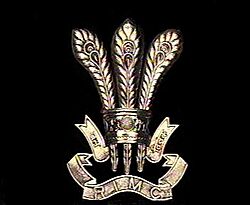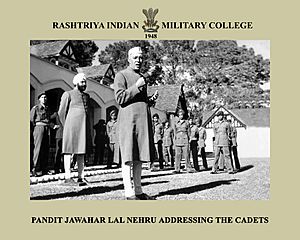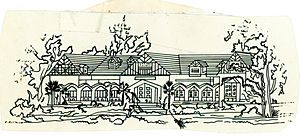Rashtriya Indian Military College facts for kids
Quick facts for kids RIMC |
|
|---|---|
 |
|
| Location | |
|
|
|
| Information | |
| Type | Military College |
| Motto | Bal Vivek (Strength and Conscience) |
| Established | 13 March 1922 |
| Founder | Prince of Wales Edward VIII |
| Grades | Classes 8–12 |
| Gender | Boys and Girls |
| Age | 11.5 years to 13 years |
| Enrollment | 250 cadets |
| Campus size | 138-acre (0.56 km2) |
| Colour(s) | Light blue and dark blue |
| Feeder to | National Defence Academy, Indian Naval Academy |
| Former pupils | Rimcollians |
| Sections | Pratap, Ranjit, Shivaji and Chandragupta |
| Website | http://www.rimc.gov.in |
The Rashtriya Indian Military College (RIMC) is a special military school for boys and girls. It is located in the beautiful Doon Valley in Dehradun, India. RIMC helps students get ready for the National Defence Academy and the Indian Naval Academy. After that, they can join the Indian Armed Forces.
Students who graduate from RIMC are called Rimcollians. Many Rimcollians have become top leaders in the Army, Navy, and Air Force. This includes leaders in India, Pakistan, and Bangladesh.
Contents
The Story of RIMC
The RIMC was once known as the Prince of Wales Royal Indian Military College. It was created because Indian leaders wanted more Indian officers in the British Indian Army.
A big step towards this goal was taken by Viceroy Lord Curzon in 1900. He started the Imperial Cadet Corps in Dehradun in 1901. This group was a very early version of what RIMC is today.
After World War I, the demand for Indian officers grew stronger. In 1921, a committee suggested opening a special school. This school would train Indian boys to become officers. They would then go to the Royal Military Academy Sandhurst in England. The British believed Indian boys needed a British-style education first.
Finally, the school opened in March 1922. Prince Edward, who was the Prince of Wales at the time, officially opened it on March 13, 1922. He named it the Prince of Wales Royal Indian Military College (PWRIMC).
When India became independent in 1947, the school's name changed. The "Prince of Wales" part was removed. It became the Rashtriya Indian Military College, or RIMC. This new name kept the spirit of the original school.
The school was built on the old grounds of the Imperial Cadet Corps. It is in a green area of Dehradun Cantonment. Its main goal was to prepare Indian boys for officer training at Sandhurst. It was like an English public school.
The first leader of the College was Lt Col H.L. Haughton. He started in February 1922. The first headmaster was JGC Scott. Many important people studied at RIMC. These include Hira Lal Atal, who helped design India’s highest bravery award, the Param Vir Chakra. Another famous student was Major Somnath Sharma, the first person to receive the Param Vir Chakra.
After India became independent in 1947, RIMC kept training young people for the Indian Armed Forces. Now, instead of Sandhurst, students aim for the NDA and INA.
In 1997, a special stamp was made to celebrate RIMC's 75th anniversary. The College celebrated its 100th birthday on March 13, 2022. This makes it the oldest officer training school in the Indian Armed Forces.
How RIMC Works
The RIMC campus covers about 54 hectares (139 acres). Around 250 students, called cadets, study here. The school has a Hawker Hunter jet aircraft and a Sea Harrier on display. These were gifts to the College.
RIMC has a great teacher-to-student ratio, with one teacher for every 14 students. Students are chosen from all over India through a national exam. This exam is held twice a year in every state. After passing the exam, students must also pass a medical test to get in. About 50 students are selected each year and join Class VIII.
In 1922, the PWRIMC was run like an English public school. The first 37 cadets were divided into three Houses, called Sections. These were named Rawlinson, Roberts, and Kitchener. These names honored three British Commanders-in-Chief of India.
After India's independence in 1948, the Section names changed. They became Pratap, Ranjit, and Shivaji. These new names honored great Indian warriors: Maharana Pratap, Maharaja Ranjit Singh, and Chhatrapati Shivaji. In 1965, a fourth Section was added, called Chandragupta. It was named after the Indian Emperor Chandragupta Maurya.
Cadets at RIMC follow the Central Board of Secondary Education (CBSE) curriculum. This prepares them for their final exams in Class 10 and 12. RIMC is unique because it holds board exams twice a year. During their time at RIMC, cadets learn what it's like to be an officer in the Indian Armed Forces.
Cadets play many sports, including hockey, football, cricket, basketball, Volleyball, squash, boxing, swimming, athletics, tennis, and gymnastics. They also learn horse riding and rifle shooting. After finishing Class 12, most cadets join the National Defence Academy in Pune.
At the NDA, they spend three years training. After that, they become officers in the Indian Armed Forces.
Academics at RIMC
The Union Ministry of Defence manages RIMC. RIMC is special because it conducts Class 10 and 12 exams twice a year, in May and November. These exams are recognized by CBSE.
The college offers science subjects for Class 11 and 12. They also teach Social Sciences to help cadets prepare for the UPSC exam. This exam is needed to enter the NDA.
After each term, a cadet's performance is reviewed. Their classwork, homework, and other achievements are all considered. This helps decide if they can move to the next class. RIMC has a very high success rate. About 70-80% of its cadets get into the NDA, which is much higher than the national average.
How to Join RIMC
RIMC admits 41 cadets every six months. To apply, candidates must be studying in Class VII. They need to be between 11.5 and 13 years old when the term starts.
The admission process includes a written exam with three parts:
- English (125 Marks)
- Mathematics (200 Marks)
- General Knowledge (75 marks)
Candidates must score at least 50% in each subject to pass the written test. Those who pass are then called for an interview (Viva-Voce), which is worth 50 marks. Finally, they must pass a medical fitness test to be admitted to the school.
Famous Rimcollians

The former students of RIMC are known as "Rimcollians". The current students are called "Rimcos". Many Rimcollians have achieved very high positions in the Armed Forces. Some have even become Chiefs of Staff in the Indian and Pakistani Armed Forces.
RIMC has produced five Army Chiefs:
- Four from the Indian Army: General K. S. Thimayya, General Sundararajan Padmanabhan, General G. G. Bewoor, and General Vishwa Nath Sharma.
- One from the Pakistan Army: General Gul Hassan Khan.
It has also produced four Air Chiefs:
- Two from the Indian Air Force: Air Chief Marshal N.C. Suri and Air Chief Marshal B. S. Dhanoa.
- Two from the Pakistan Air Force: Air Marshal Asghar Khan and Air Marshal Nur Khan.
Many Rimcollians have received bravery awards. These include the Victoria Cross given to Lieutenant General Premindra Singh Bhagat. Also, the Param Vir Chakra was awarded to Major Som Nath Sharma.
The school has an alumni group called the Rimcollian Old Boys Association (ROBA). This group helps former students stay in touch.
Sports at RIMC
Sports are a big part of life at RIMC. Cadets play many games like boxing, football, cricket, athletics, horse riding, hockey, squash, swimming, and shooting. RIMC has helped produce international-level athletes in squash, shooting, and horse riding.
Some famous squash players from RIMC include Nishkal Dwivedi and Brig. Raj Manchanda. Poshuk Aluwalia, an alumnus, won a medal for India in shooting at the 2010 SAF games. Piyush Sunil Deshmukh represented India in an International Horse Show in Australia and won four medals.
The Times Magazine has even named RIMC India's best school for sports education.
RIMC has excellent sports facilities. These include a 50-meter Olympic-size swimming pool, an indoor swimming pool, five basketball courts, three squash courts, and many football and hockey fields.
Major Ashish Malik, a former student, won a team silver medal at the 2018 Asian Games for India.
The House System
The school is divided into four houses, also called Sections. Every cadet is placed into a house when they join RIMC. They stay in that house throughout their time at school.
These houses were originally named Rawlinson, Kitchener, and Roberts. After India's independence, they were given new names. Each house has a House Master (called Section Master) and one or two Section Tutors. There is strong competition between the houses, which continues even after students graduate.
Here are the houses and their colors:
| House | House colour |
|---|---|
| Pratap | |
| Ranjit | |
| Shivaji | |
| Chandragupta |
See also
- List of Rimcollians
- National Cadet Corps (India) (NCC)
- National Police Cadet Corps (India) (NPCC)
- National Service Scheme (NSS)
- Rashtriya Military Schools (RMS)
- Sainik School



